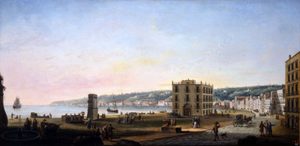Posillipo from the Riviera di Chiaia
Artist: Gabriele Ricciardelli
On display
This is one of the views of the hill of Posillipo depicted from the Riviera di Chiaia, by the Neapolitan promenade, one of the favourite spots of British Grand Tourists. From the eighteenth century, travellers to Naples reported in their accounts the pleasantness of the Real Passeggio di Chiaia (or Royal Chiaia Walk), which offered a perfect setting for admiring the landscape and proximity to the sea, while observing the living city life. With the increasing popularity of sea bathing, and the desire to escape from the heat and noise of the city, Posillipo, along the northern coast of the bay of Naples, soon became a retreat for the very wealthy. No longer after this canvas was painted, the artist and architect Luigi Vanvitelli designed the Villa Reale (or Royal Villa), built by the Riviera di Chiaia between 1778 and 1780, and which it is still possible to walk today.
In this, as well as in all Ricciardelli’s several views of the city, human component is reduced to mere figurines, while great attention is given to architectures and urban atmospheres. Diaphanous light, transparencies in pale tones, and watercolour effects have almost none of the sunny luminosity and of the warm shades of the Neapolitan landscape. They probably responded to the taste and sensitivity of the British patrons who visited Naples during their Grand Tour and commissioned the artist a number of nostalgic replicas of his more famous views of the city, which found their way to Britain and can still be seen in many British country houses.
Ricciardelli was among the best known vedutisti of the eighteenth century, as artists who specialised in realistic scenes of both landscapes and cities were called. Although there is little known about his life, Ricciardelli is often documented in England and Ireland, where his first stay is dated between 1753 and 1759 at service of local patrons for whom he produced various Neapolitan views as well as English and Irish landscapes. This canvas is similar to one from a series of Neapolitan views that were engraved by the Flemish Antonio Cardon, published in Naples in 1765, and thus dated about 1764, after artist’s first return to Naples.
Details
- Artist
- Gabriele Ricciardelli
- Title
- Posillipo from the Riviera di Chiaia
- Date
- About 1764
- Medium
- Oil on canvas
- Dimensions
- 88.5 x 153 cm (unframed); 114.5 x 147 cm (framed)
- Reference
- CVCSC:0190.S
- Collection
- Naples

